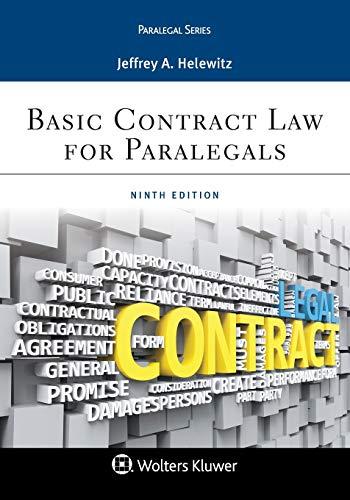Question
Is the award of damages proper? Do traditional pole holes in fire stations pose a risk to firefighters? Should pole holes be eliminated? Was the
Is the award of damages proper?
Do traditional pole holes in fire stations pose a risk to firefighters? Should pole holes be eliminated? Was the award in this case warranted?
Jones v. City of Seattle, Washington
314 P.3d 380, 2013 Wash. Lexis 955 (2013)
Supreme Court of Washington
"The trial judge characterized the city's motion as an attempt to get a 'second bite of the apple.'"
McCloud, Justice
Facts
Mark Jones was a firefighter for the city of Seattle, Washington. He was assigned to Station 33 firehouse, where he remained on duty for long shifts including staying overnight. Jones slept in quarters on the second floor of the firehouse. One of the common features of many firehouses, including the one Jones worked in, is the pole hole in the second floor with a pole leading to the first floor. When called to action, firefighters slide down the pole to reach the first floor and their firefighting equipment and vehicles. One night, around 3:00 a.m., Jones fell 15 feet through the fire station's pole hole. Jones told a responding medic that he had awoken to use the bathroom, which was next to the pole hole. Jones sustained both serious physical and cognitive impairments because of his fall. Because of his permanent impaired mental and physical injuries, Jones's sister Meg was appointed his guardian. Meg, on behalf of Jones, sued the city of Seattle for injuries caused to Jones by the accident, alleging that the city had been negligent in failing to block accidental access to the pole hole. The jury found that the city's negligence was the sole cause of Jones's injuries and awarded him $12.75 million in damages. The court of appeals upheld the verdict and damages. Seattle appealed to the supreme court of Washington, seeking a new trial regarding damages.
Language of the Court
The first two weeks of the trial were devoted to testimony by Jones's treating physicians, various witnesses who spoke to the general condition and layout of Station 33, to the city's ability to prevent accidents like Jones's, and to Jones's demeanor, habits, and capabilities since the accident. The various physicians and therapists who took the stand uniformly testified that Jones had significant and permanent cognitive impairments. The trial judge characterized the city's motion as an attempt to get a "second bite of the apple" after its strategic choices proved unwise.
Decision
The supreme court of Washington upheld the damage award to Jones against the city of Seattle.
Step by Step Solution
There are 3 Steps involved in it
Step: 1

Get Instant Access to Expert-Tailored Solutions
See step-by-step solutions with expert insights and AI powered tools for academic success
Step: 2

Step: 3

Ace Your Homework with AI
Get the answers you need in no time with our AI-driven, step-by-step assistance
Get Started


